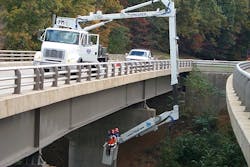FHWA’s National Bridge Inspection Standards program reaches milestone
A reliable transportation system relies on a robust inventory of highway bridges. Regular and thorough inspections of our nation’s bridges are critical to maintaining safe bridge operations and preventing structural or functional failures. In addition, data on the condition and performance of our nation’s bridges are needed for bridge owners to make informed investment decisions as part of an asset management program.
The Federal Highway Administration’s national bridge inspection program has been at the core of highway bridge safety and commemorates its 50th anniversary this year. The program requires regular bridge inspections and data collection by trained professionals.
But it wasn’t always that way.
With authority provided by Congress in the Federal-aid Highway Act of 1968, the FHWA enacted National Bridge Inspection Standards (NBIS) regulations on April 27, 1971, officially creating the first federal level bridge safety program. The NBIS was the direct result of the Silver Bridge collapse in Point Pleasant, West Virginia, on December 15, 1967 which claimed the lives of 46 people. That tragedy brought national attention to the issue of bridge safety, and led to a systematic effort to ensure bridge safety nationwide.
The NBIS required that bridges and their various component parts—ranging from pilings to deck slab—be inspected at least once every two years by inspectors that were appropriately trained. It also required written reports of the inspection findings that include needed follow-up actions to address any identified damage, deterioration, or defects. In addition, FHWA was charged with using the bridge inspection data to create the National Bridge Inventory to track the performance of highway bridges.
The NBIS applies to all highway bridges on all public roads. While FHWA developed, implemented, and maintains the NBIS, its primary role in the program is to provide oversight of state, federal, and tribal bridge inspection programs that implement the NBIS as states, local agencies, federal agencies—such as the National Park Service—and Tribal governments own most highway bridges. FHWA assesses compliance with the regulations through a detailed annual review process.
Bridges are inspected regularly—typically every 24 months—and the results are reported to FHWA. If a bridge is deemed unsafe, immediate action is taken which could include closure, prompt repair, or load posting to inform heavy vehicle operators not to use the bridge.
Even as the number of bridges in the NBIS program grew from 587,735 to 618,456 over the last 20 years, the program continues to ensure they are safe for the public. In that same time period, the percentage of bridges in poor condition dropped from 15.2% to 7.2%.
After a half-century and millions of bridge inspections, FHWA’s bridge inspection standards continue to ensure that only safe bridges are open to traffic. For years to come, the program will continue to evolve, using state-of-the-art training and equipment, to serve the needs of the nation’s traveling public.
---------------
This news story contributed by Joey Hartmann, director for the Office of Bridges and Structures at the Federal Highway Administration.
